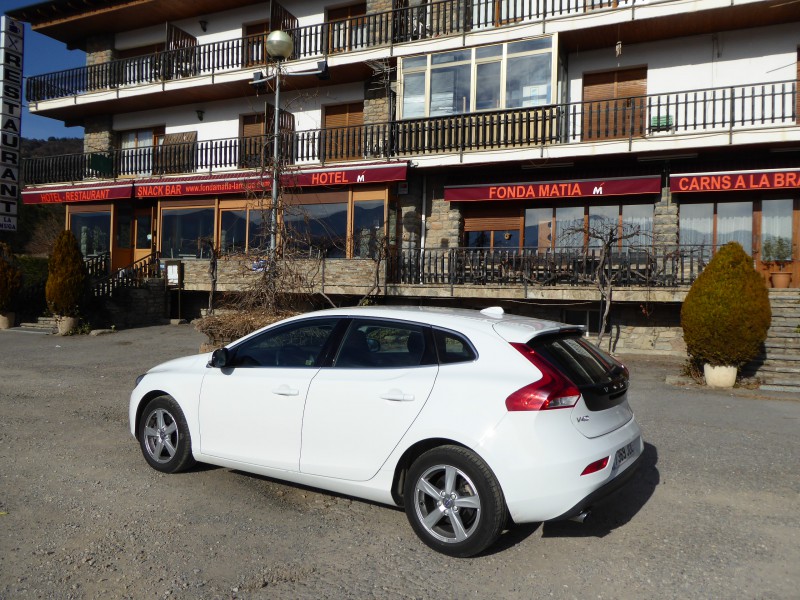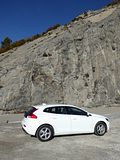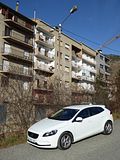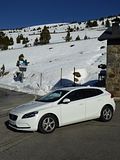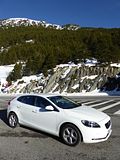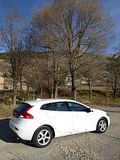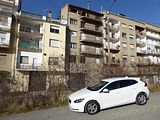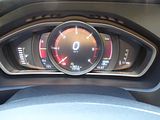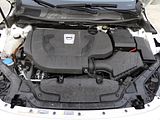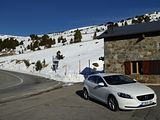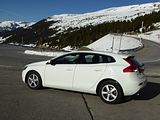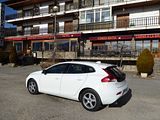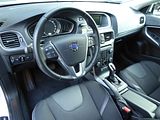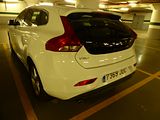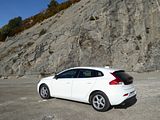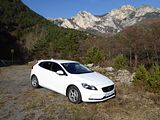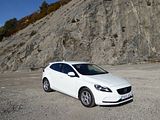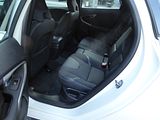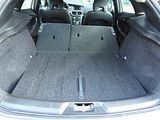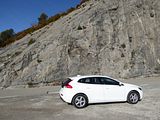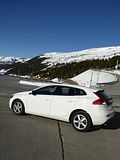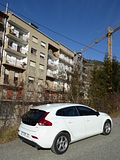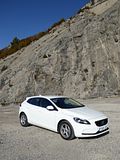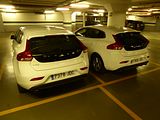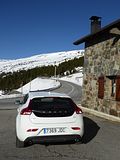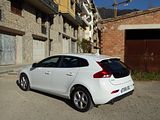
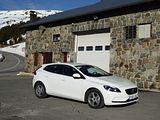
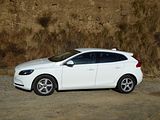
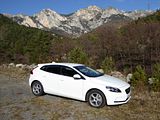
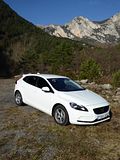
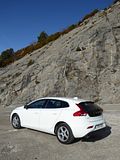
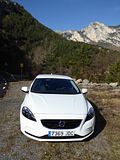
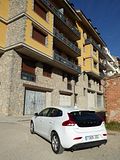

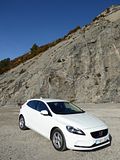
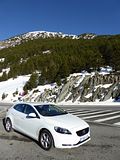

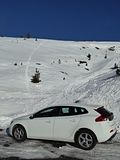

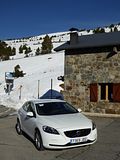
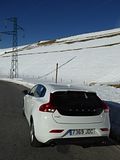

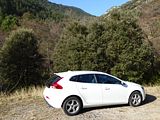
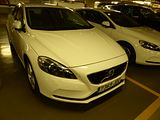
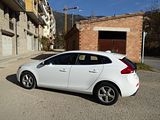
The latest V40 was launched at the 2012 Geneva Show, solely as a 5 door hatchback, and available with a range of petrol and diesel engines, all turbocharged. The styling, whilst distinctive, left you in no doubt that this was a Volvo, with a clear resemblance to the other models in the range, hiding well the fact that underneath this car was based on the P1 platform which also underpinned the Ford Focus and Mazda 3. Those cars were well respected for their driving dynamics, which meant that the V40 had the potential to be good to drive, as well as bringing all Volvo’s established credentials for safety and quality of design and finish to the market. The initial press reports were extremely favourable, and it looked as if the Swedes may just have hit the winner they were looking for. And then the press got hold of UK spec cars, and drove them in the UK, and the reports changed from “potential class leader” to “very good, but not quite the best”. What they look for, and what matters to me are not exactly the same, though, so the dilution of enthusiasm did not rub off on me, and this remained an interesting car that I was particularly keen to try. Hertz in the UK got quite a lot of them on fleet during 2013, with an array of different models, in manual and automatic forms, but whenever I went to get a car from them, there never seemed to be any available, which suggested that the cars were popular among the renters. Finally, my chance came in Spain when I had booked a regular C-Segment hatch, and was expecting a SEAT Leon or a Hyundai i30, and I was kindly upgraded into this car, a D3 model in Crystal White Metallic. Hertz Espana clearly have quite a few of these cars, in this colour, as when I got to the hotel, I was able to park next to an identical car with a registration plate that only differed by a few numbers.
That the test car was a diesel was sadly rather evident when I started it up, something you do by putting the key into a slot quite high on the dash to the right of the wheel, before you then press the “Start/Stop” button above it. The characteristic sound of the diesel engine reverberated around the rental car garage, and was indeed to remain slightly too evident throughout the test. It does, of course, get a lot quieter as the engine warms up and you get underway, but there were times, especially with a trailing throttle when the noise was more present than it really should be in a car with the aspirations that this one has. The test car was badged D3, which puts in the middle of three diesel powered models offered in Spain. Diesel is very much the core of the Spanish range, with initially just one petrol model offered, the T4, which at 187 bhp is one of the more powerful petrol of a series that are offered in other markets. The numbers no longer denote the cylinder count, as they used to do, but simply relative performance to other models in the range. The D2 has a 1.6 litre engine, whereas this D3 – in Spanish spec – has the larger 2 litre unit, as does the more potent D4 model. It puts out 150 bhp. A six speed manual is the standard offering, but the test car came with the optional six speed automatic, which increases the CO2 output from 99 to 104 g/km, still an impressively low figure. The pairing of this transmission and the D3 engine worked well, with the gearbox seemingly always finding the appropriate ratio for your speed and acceleration. The D3 is not fast. 150 bhp in a car of this size and weight is no longer that much, but nor is it slow, and the Volvo coped well not just with the gradual climbs out of Barcelona, but also the more testing slopes in Andorra where I took it for one of the days of my test. As an indication of how those slopes can affect things, when I paused to take advantage of much cheaper fuel prices in Andorra, just before passing back into Spain, the fuel gauge reported that I had now got an available range of 2000km.
I’ve never seen that in any car before. This was clearly based on how little fuel the V40 had sipped in the preceding 40km or so as I had descended from the high point of the road which goes over the Pyrenees towards France. That was something of a false expectation to set, as of course the car is not quite that economical, but it was still decently miserly on fuel, averaging 55 mpg in my custody. Whilst it did not quite hit the standards achieved by the last generation Focus, and indeed the Mazda, this was also a very agreeable car to pilot. The steering proved well judged with lots of feel, and a very clear indication of what the wheels would do next. The weighting was spot on, with a nice linear progression as you turned the wheel, and plenty of assistance to help you when manoeuvering in tight spaces, something that is a reality in Spanish cities and underground car parks. The handling proved good, too. My test notes used the word “tidy”, and that probably sums it up. Well policed roads, adorned with speed cameras are not the place to hoon around, especially once you are above the snow line, as the pictures evidence that I was in Andorra, so this was not a track test evaluation, which is where the UK press’ diminution of their praise stemmed from, but out on real roads, this is a nice car to drive. It rides well, though it has to be said that Spanish road surfaces are generally a lot better than British ones, which is perhaps again why the UK press were less convinced on home soil. Noise levels are well suppressed whilst underway, with the engine the most obvious, but only at times. There are powerful brakes fitted, though I did not have any cause to test them to the ultimate. A conventional pull-up parking brake is fitted between the seats. Visibility is reasonable, though the thick pillars, especially at the back do make it a little challenging over your shoulder some times.
Whereas the Ford and Mazda whose platform the V40 shares may edge this car on driving dynamics, they can’t get even close to the Volvo on the quality of their interiors. One look at this, and you really do feel that the word “premium” is justified. Volvo has built a reputation in recent years from producing an interior which probably only Audi can equal or beat in terms of elegance of design and quality of materials, and the same attributes that you find in far more expensive Volvo models transfer down to the V40. The plastics chosen are absolutely first rate, with a lovely texture to them and a very soft squashy feel if you touch them. There is judicious use of inlays, with chrome highlight rings around the instrument binnacle, the air vents, the steering wheel spokes and the gearlever surround, all of which look classy. The dash itself is neat and unfussy looking – stereotypically Swedish, you might say. There is a large moulding which sweeps across the width of the car, sloping down gradually toward the passenger side, but embracing not just the instrument binnacle, but also the integrated display screen for the infotainment system. The instruments are all electronic, and light up when you open the door and put the key in that slot. There are three modes, I discovered after the test, showing “performance”, “eco” and “elegance”. The car had them set to the first of these and I did not change it. Performance means that you get a red background hue to the dials and it changes one of them. There is a single traditional dial, in the middle with, in “performance” view, a digital speed read reading in the centre and a rev counter around the perimeter and odometer functions in the bottom. Change to the other views, and you get a more conventional speedometer around the edge of the central dial, as well as different background colours. To either side are a pair of vertically arranged bar charts, showing fuel level and water temperature, whereas to the right is a “power” dial, and a schematic showing the currently selected gear ratio. The graphics are very crisp indeed. The centre of the dash has a high mounted colour display screen for the audio/infotainment system, below which you find a couple of air vents, then on a floating panel, with stowage space behind, arranged in a vertical pattern are the controls for the audio system and the air conditioning. Centrepiece of this is a pictogram showing the human form, which then allows you to indicate where you want the air to flow. Rotary knobs around the side are used for the audio settings. Twin chunky column stalks are used for the wipers and indicators, and the lights operate from a rotary dial on the dash to the left of the wheel. The steering wheel boss contains buttons for cruise control and audio repeaters. It all proved straightforward to assimilate and use.
You get leather seats in top spec models, but the test car was cloth trimmed. But it was nice quality cloth and the interior was a very agreeable place to sit in. Seat adjustment was all manual, with levers on the side of the seat for backrest angle and seat height as well as a bar under the seat for fore/aft positioning. The seat itself proved supremely comfortable, one of those things you just expect with a Volvo, where design of something anatomically approved has long been a feature. The steering column had in/out as well as up/down adjustment to it, so it was easy to get a good driving position. The wheel itself was leather wrapped and very pleasant to hold.
The rear of the V40 is really laid out for 2 people. The middle part of the seating has a flat unshaped portion to it, with a loop near the front which, when you pull it, raises the very front portion to reveal a pair of cupholders. You could put a third person here, but even though there is not much of a transmission tunnel to deprive them of leg room, they would not be anything like as comfortable as those in the two shaped seats. Those occupants will be decently well provided with legroom, and despite the slight slope to the roof, will also not lack headroom. The boot had a false floor fitted, which meant that the load area was completely flat when the asymmetrically split rear seat cushions had been dropped forwards. With the seats erect, there is not a particularly large space, and it is rather shallow, though you would be able to tuck things under that false floor. If you wanted more depth, you could easily remove the floor, I guess. Inside the cabin, there is a decent sized glove box, there are bins on all four doors, there is a cubby under the central armrest and in front of this is a lidded area which contains the pair of cupholders. Rear seat passengers get map pockets on the back of the front seats as well as little moulded areas on the side of the seats, between seat and door.
Five different trims are offered on Spanish market V40s: Basico, Kinetic, Momentum, Inscription and R-Design, and there are 3 diesel engines and 1 petrol. Not all trims are on all models, with the Basico being confined to the D2, for instance. The test car was a Kinetic. The recognition points are the black rubber decoration, as opposed to chrome around the side windows and the Matres 205/55 R16″ alloy wheels. There are adjustable exterior mirrors and a roof spoiler, of what Volvo call “High Performance” design for all bar the D2. There are a full complement of safety systems including: ABS; a knee airbag for the driver; airbags for pedestrians; an Inflatable Curtain; two stage airbags for driver and front passenger; seatbelt warning in all positions; seat belts with pretensioners; ESC; EBA (Emergency Brake Assistance) and EBD (Electronic Brake Distribution); Isofix attachments; HSA and IDIS (Intelligent System Driver Information; adaptive brake lights; RSC (Stability Control Roll); SIPS System (Side Impact Protection) with SIPS (Airbags Laterals, as well as WHIPS (System Whiplash protection). Inside you get cloth seats, a folding driver seat with lumbar adjustment; the Electronic Information Centre; remote central locking; dual zone electronic climate; front and rear electric windows; illuminated vanity mirrors; outside temperature indicator; folding front passenger seat backrest ; rear seatbacks asymmetrically folding 60/40; Air Quality System; adjustable steering wheel (vertical /horizontal); a charcoal-finished centre console; door bins; pollen filter; front reading lights and lower lights; Profiles chrome audio and climate controls; front armrest with cupholders; a slider in front centre console; leather-wrapped steering wheel, gearlever and handbrake and au audio system with 5″ colour screen, CD slot, AUX, MP3 and Bluetooth. Costing around another €1250, the Momentum trim adds: Markeb 16″ Diamond Cut alloys; LED lights on the front bumper; height adjustment to both front seats, with a passenger seat lumbar adjustment; cruise control; a multi-function control steering-wheel; a rear armrest and cup holders; System rearview mirror with auto-dimming; electrically retractable door mirrors with illumination; a rain sensor detection system; upholstery in “LinnéeTexti”, aluminium door kickplate, and a leather-wrapped steering wheel. In addition to the items on the Momentum, the extra €2250 you pay for an Inscription trim includes: chromed grille with “Inscription” badging; bright decor around side windows; chrome decor headlights; milled aluminium trim inserts; Sarpas 7,5×17 “Diamond Cut” alloy wheels; LED lighting; an illuminated gearlever; a forward sliding armrest; partial leather upholstery and door sills with the “Inscription” logo on them. The top spec R-Design is intended to the sporty version, but it is rather more subtle than an Audi S-Line or BMW M-Sport model in the way it presents itself. It builds on Momentum trim, and as such it is actually cheaper than the Inscription, saving around €300, bringing along an R-Design grille, trim around the side windows, R-Design badging on the tailgate, R-Design logos on the door sills, an aluminium centre console, R-design leather wrapped handbrake, a rear diffuser, twin exhaust pipes, lower profile 225/45 R17 alloy wheels of Ixion design, 10mm lower ride height, electrically folding door mirrors, Tapiciera R-Design leather upholstery, a sports leather wrapped steering wheel, rear armrest with cupholders, a sliding front armrest.
I rather liked the V40. Indeed, it proved well worth the wait to get behind the wheel. The only demerits I could see were the slightly gruff diesel engine, but its efficiency with fuel and indeed Carbons, probably more than atoned for that, and the fact that five people and their luggage would be a very tight squeeze. Otherwise, it went well, was good to drive, proved very comfortable, was nicely finished inside, and scores because it is something that bit different, selling at a far slower rate than the German rivals for no particularly rational reason. I would want to try one in the UK, to make sure that my enthusiasm for the car does not diminish in the way that those picky UK journalists said (but they have a very precise set of priorities, few of which pertain to driving on public roads in a car that they have funded themselves!). I have little doubt that it would not.

